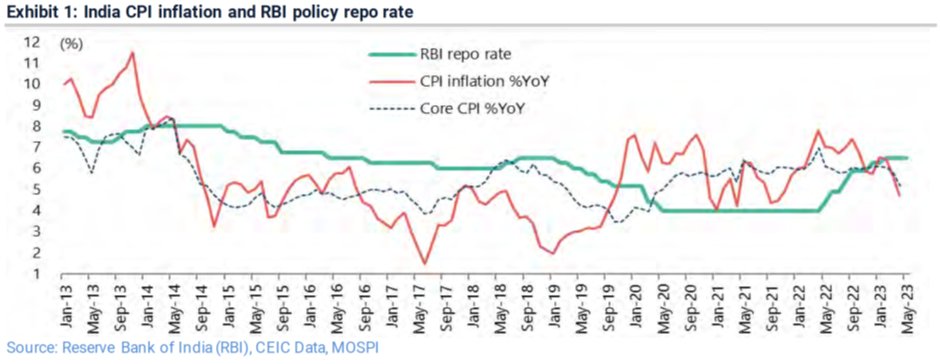As India pitches for ratings upgrade, reminding @SPGlobalRatings @MoodysInvSvc @FitchRatings @DBRSMorningstar using evidence from #EcoSurvey2021 why India's sovereign rating must be upgraded several notches🧵1/20
For details, see indiabudget.gov.in/budget2021-22/…
business-standard.com/economy/news/i… twitter.com/i/web/status/1…
For details, see indiabudget.gov.in/budget2021-22/…
business-standard.com/economy/news/i… twitter.com/i/web/status/1…
1. 5th largest eco has never been ranked as low as India is👇
Rating=Probability of Default =f(Ability2Repay + Intent2Repay)
GDP best reflects Ability2Repay=> ratings criteria used by @SPGlobalRatings @MoodysInvSvc @FitchRatings @DBRSMorningstar is conceptually FLAWED. 2/20
Rating=Probability of Default =f(Ability2Repay + Intent2Repay)
GDP best reflects Ability2Repay=> ratings criteria used by @SPGlobalRatings @MoodysInvSvc @FitchRatings @DBRSMorningstar is conceptually FLAWED. 2/20

2. Rating=Probability of Default =f(Ability2Repay + Intent2Repay)
As forex reserves r used to repay external (i.e. foreign currency) debt & short-term debt is repayable over 1-yr, short-term external debt as % of reserves capture Ability2Repay.
India is CLEAR +ve outlier👇3/20
As forex reserves r used to repay external (i.e. foreign currency) debt & short-term debt is repayable over 1-yr, short-term external debt as % of reserves capture Ability2Repay.
India is CLEAR +ve outlier👇3/20

Rating=Probability of Default =f(Ability2Repay + Intent2Repay)
As India has never defaulted on its debt (even in 1991 when facing worst BoP crisis, India shipped gold as collateral but didn't default), India's Intent2Repay is GOLD STANDARD & is a CLEAR +ve outlier👇4/20
As India has never defaulted on its debt (even in 1991 when facing worst BoP crisis, India shipped gold as collateral but didn't default), India's Intent2Repay is GOLD STANDARD & is a CLEAR +ve outlier👇4/20

Take ANY metric that @SPGlobalRatings @MoodysInvSvc @FitchRatings @DBRSMorningstar use and India is a +ve outlier.
GDP growth & Inflation👇5/20
GDP growth & Inflation👇5/20

Take ANY metric that @SPGlobalRatings @MoodysInvSvc @FitchRatings @DBRSMorningstar use and India is a +ve outlier.
General Govt Debt & Primary Balance (or Primary Deficit)👇6/20
General Govt Debt & Primary Balance (or Primary Deficit)👇6/20

Take ANY metric that @SPGlobalRatings @MoodysInvSvc @FitchRatings @DBRSMorningstar use and India is a +ve outlier.
Current Account Balance & Investor Protection👇7/20
Current Account Balance & Investor Protection👇7/20

Take ANY metric that @SPGlobalRatings @MoodysInvSvc @FitchRatings @DBRSMorningstar use and India is a +ve outlier.
Political Stability & Govt. Effectiveness👇8/20
Political Stability & Govt. Effectiveness👇8/20

Take ANY metric that @SPGlobalRatings @MoodysInvSvc @FitchRatings @DBRSMorningstar use and India is a +ve outlier.
Rule of Law & Control of Corruption👇9/20
Rule of Law & Control of Corruption👇9/20

Take ANY metric that @SPGlobalRatings @MoodysInvSvc @FitchRatings @DBRSMorningstar use and India is a +ve outlier now.
Short term external debt & Adequacy of Forex Reserves 👇10/20
Short term external debt & Adequacy of Forex Reserves 👇10/20

Take ANY metric that @SPGlobalRatings @MoodysInvSvc @FitchRatings @DBRSMorningstar use and India is a +ve outlier.
Past GDP growth & Past Inflation👇11/20
Past GDP growth & Past Inflation👇11/20

Take ANY metric that @SPGlobalRatings @MoodysInvSvc @FitchRatings @DBRSMorningstar use and India is a +ve outlier.
Past General Govt Debt & Past Primary Deficits👇12/20
Past General Govt Debt & Past Primary Deficits👇12/20

Take ANY metric that @SPGlobalRatings @MoodysInvSvc @FitchRatings @DBRSMorningstar use and India is a +ve outlier.
Past Current Account Balances & Past Investor Protection👇13/20
Past Current Account Balances & Past Investor Protection👇13/20

Take ANY metric that @SPGlobalRatings @MoodysInvSvc @FitchRatings @DBRSMorningstar use and India is a +ve outlier.
Past Political Stability & Past Govt Effectiveness👇14/20
Past Political Stability & Past Govt Effectiveness👇14/20

Take ANY metric that @SPGlobalRatings @MoodysInvSvc @FitchRatings @DBRSMorningstar use and India is a +ve outlier.
Past Rule of Law & Past Control of Corruption👇15/20
Past Rule of Law & Past Control of Corruption👇15/20

Take ANY metric that @SPGlobalRatings @MoodysInvSvc @FitchRatings @DBRSMorningstar use and India is a +ve outlier.
Past Ease of Doing Business (I know this is stopped but still useful as an indicator)👇16/20
Past Ease of Doing Business (I know this is stopped but still useful as an indicator)👇16/20

"Why the sovereign ratings are conceptually flawed?"
When sovereign rating models were developed in 1990s, GDP per capita was a good EMPIRICAL (NOT CONCEPTUAL) predictor of ability & willingness to repay. 17/20
When sovereign rating models were developed in 1990s, GDP per capita was a good EMPIRICAL (NOT CONCEPTUAL) predictor of ability & willingness to repay. 17/20
"Why sovereign ratings are conceptually flawed?"
Post GFC, several European countries with high GDP per capita defaulted. Yet, the sovereign ratings model has ONLY been TWEAKED, NOT fundamentally overhauled by @SPGlobalRatings @MoodysInvSvc @FitchRatings @DBRSMorningstar 18/20
Post GFC, several European countries with high GDP per capita defaulted. Yet, the sovereign ratings model has ONLY been TWEAKED, NOT fundamentally overhauled by @SPGlobalRatings @MoodysInvSvc @FitchRatings @DBRSMorningstar 18/20
@SPGlobalRatings @MoodysInvSvc @FitchRatings @DBRSMorningstar must build model conceptually as:
Rating=Probability of Default= f(Ability2Repay + Intent2Repay)
Primary Determinants:
Ability2Repay=f(GDP, External Debt/GDP, Debt/GDP, Reserves)
Intent2Repay=f(Prior Defaults)... 19/20
Rating=Probability of Default= f(Ability2Repay + Intent2Repay)
Primary Determinants:
Ability2Repay=f(GDP, External Debt/GDP, Debt/GDP, Reserves)
Intent2Repay=f(Prior Defaults)... 19/20
Secondary Determinants:
Ability2Repay=f(GDP growth,Inflation,Primary Balance,Current A/c Deficit)
Intent2Repay=f(Rule of Law,Investor Protection, Political Stability,Govt. Effectiveness,Control of Corruption) @SPGlobalRatings @MoodysInvSvc @FitchRatings @DBRSMorningstar End🧵
Ability2Repay=f(GDP growth,Inflation,Primary Balance,Current A/c Deficit)
Intent2Repay=f(Rule of Law,Investor Protection, Political Stability,Govt. Effectiveness,Control of Corruption) @SPGlobalRatings @MoodysInvSvc @FitchRatings @DBRSMorningstar End🧵
• • •
Missing some Tweet in this thread? You can try to
force a refresh














